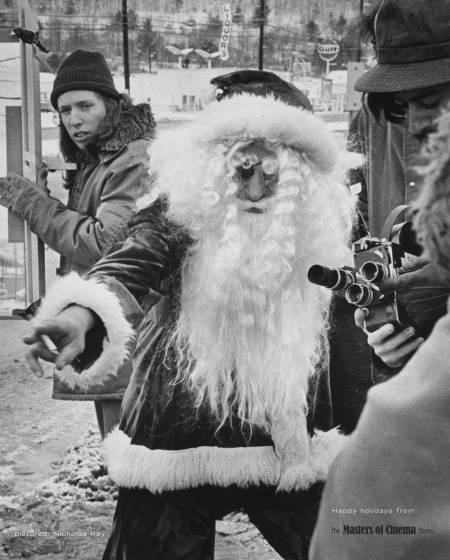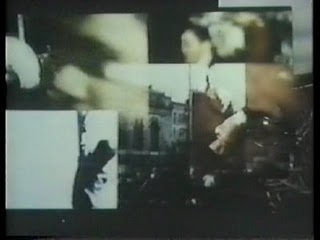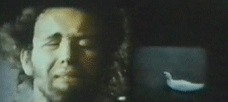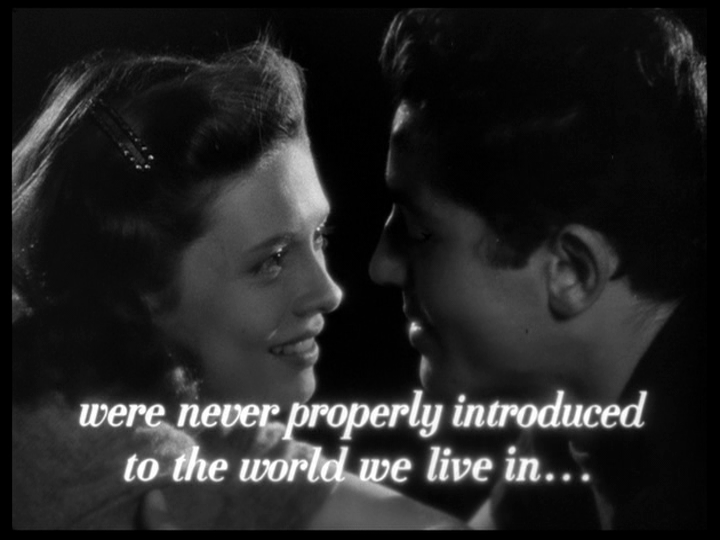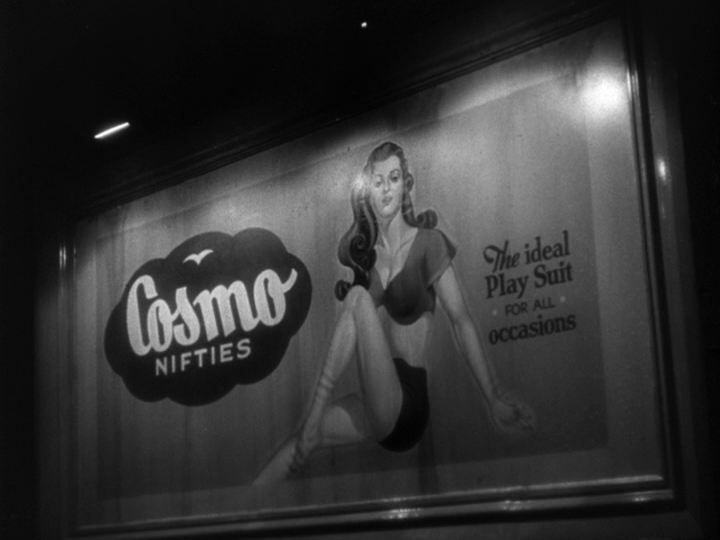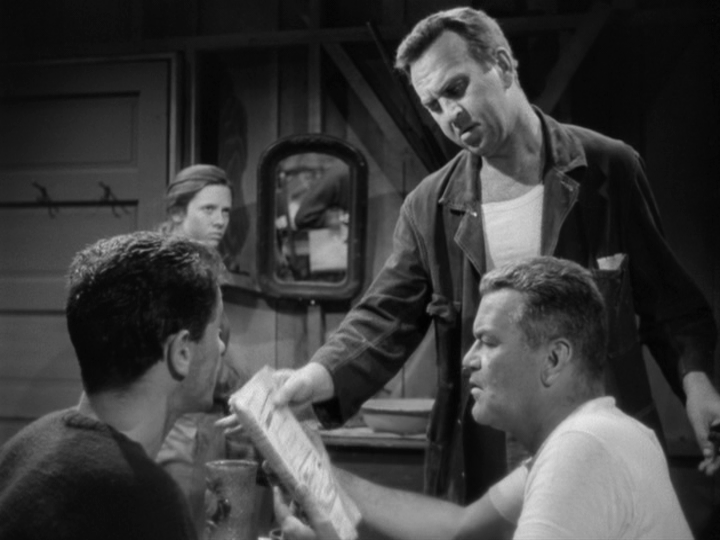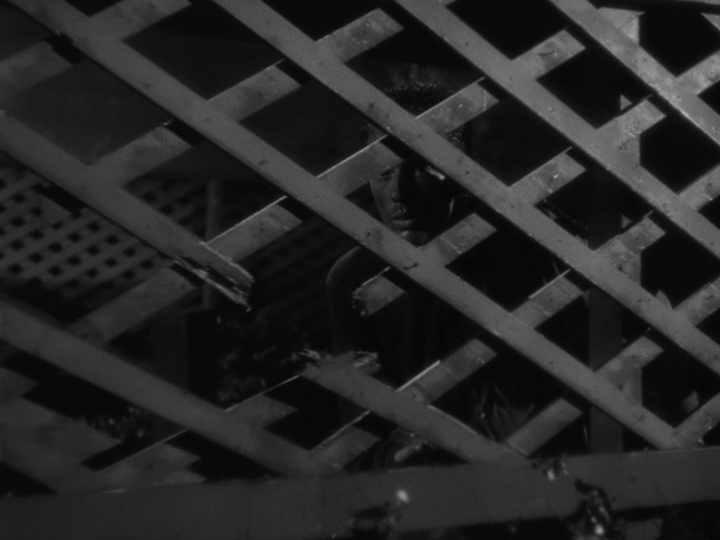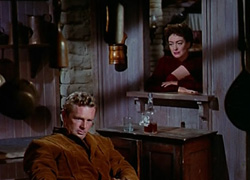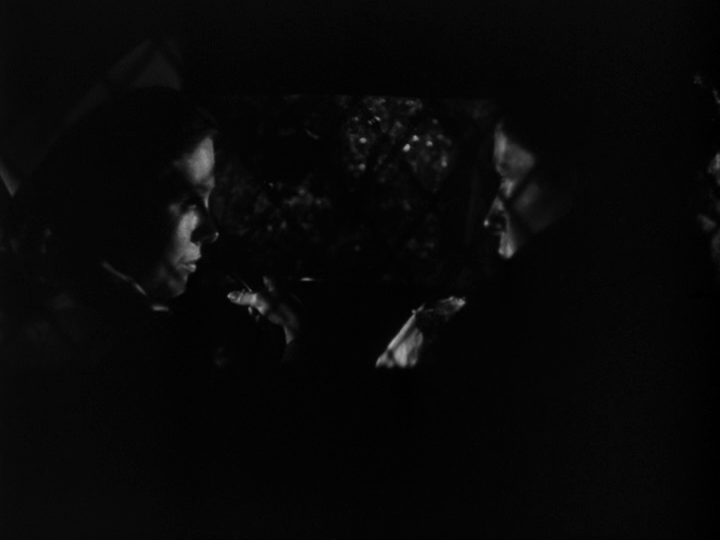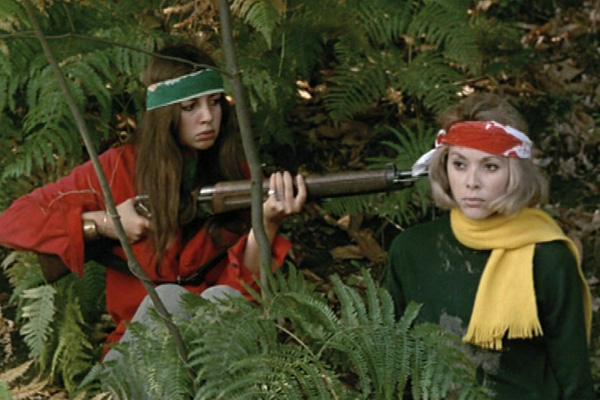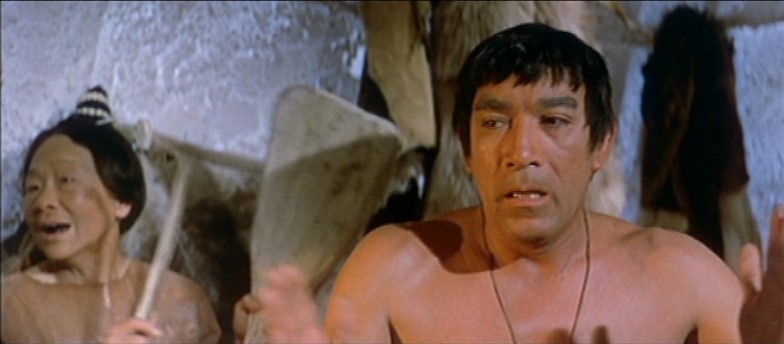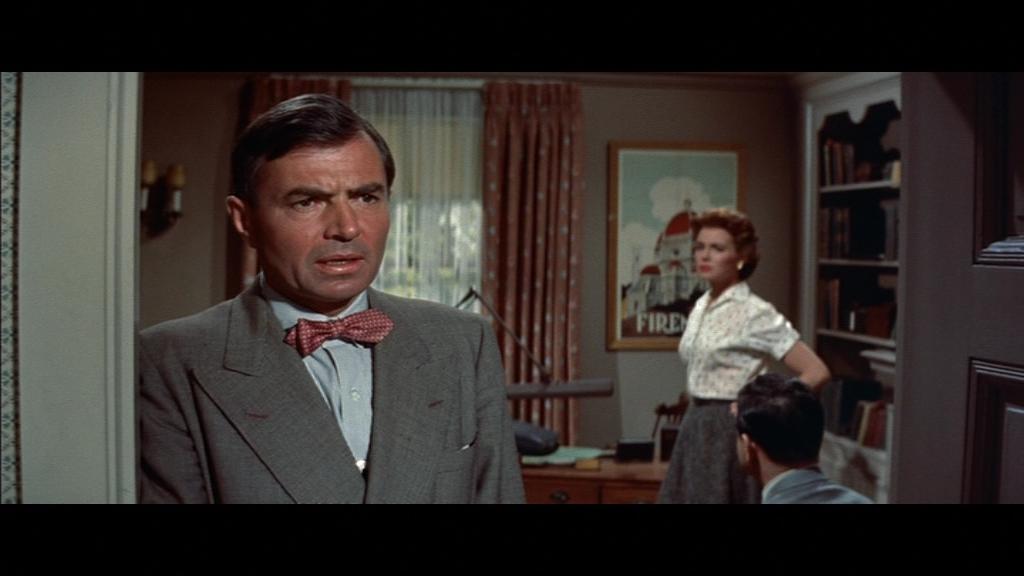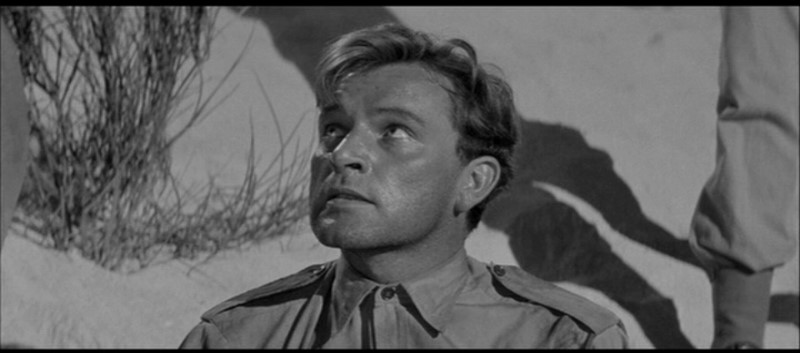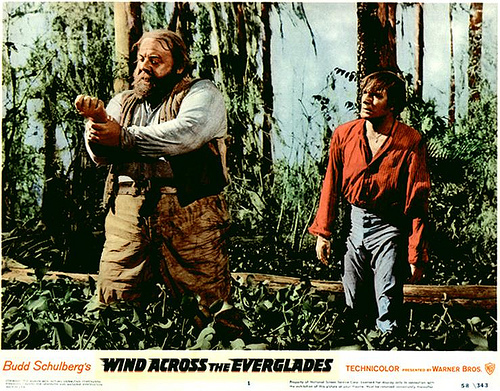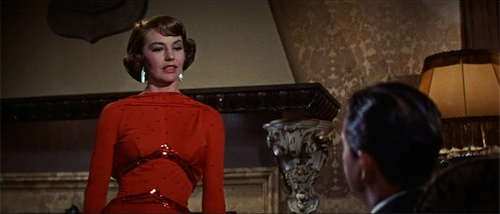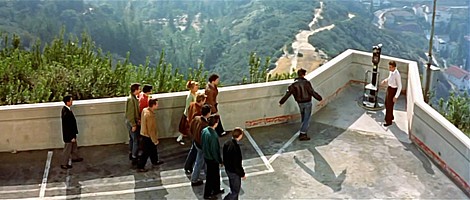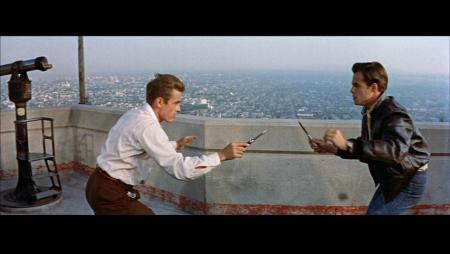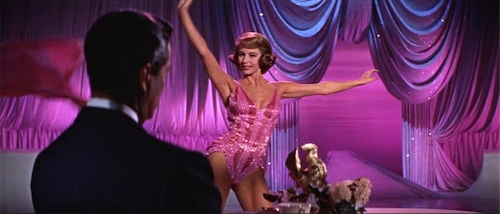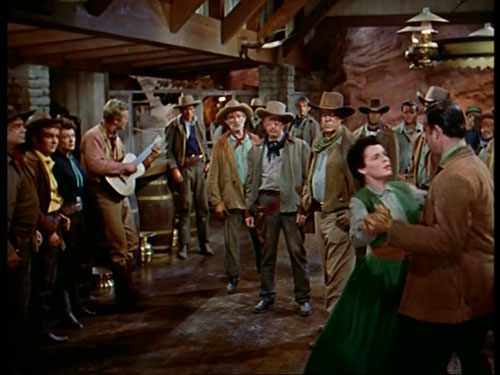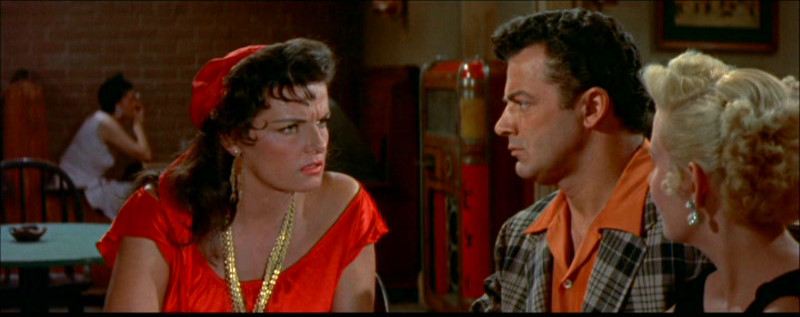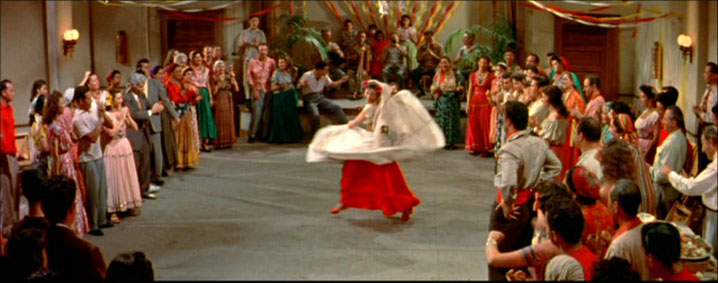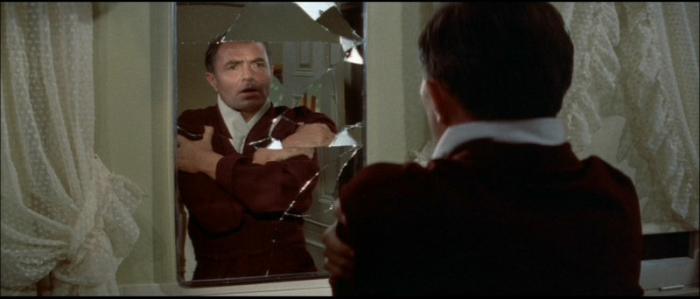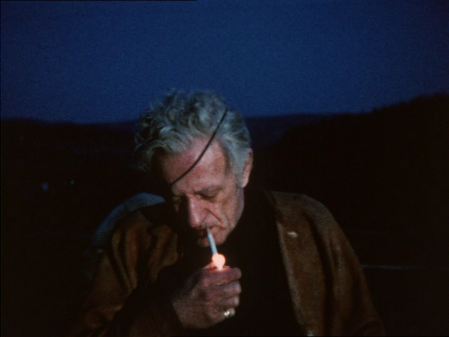From the Autumn 1973 issue of Sight and Sound. — J.R.
Surfacing in Cannes in the worst of conditions — not quite finished, unsubtitled, shrieking with technical problems of all kinds, and dropped into the lap of an exhausted press fighting to stay awake through the fifteenth and final afternoon of the festival — Nicholas Ray’s WE CAN’T GO HOME AGAIN may have actually hurried a few critics back to their homes; but it probably shook a few heads loose in the process. Clearly it wasn’t the sort of experience anyone was likely to come to terms with, much less assimilate, in such an unfavorable setting, although the demands it makes on an audience would be pretty strenuous under any circumstances.
Created in collaboration with Ray’s film class at the State University of New York at Binghamton, and featuring Ray and his students, the film attempts to do at least five separate things at once: (1) describe the conditions and ramifications of the filmmaking itself, from observations at the editing table to all sorts of peripheral factors (e.g., a female student becoming a part-time prostitute in order to raise money for the film); (2) explore the political alienation experienced by many young Americans in the late 60s and early 70s; (3) demystify Ray’s image as a Hollywood director, in relation to both his film class and his audience; (4) implicate the private lives and personalities of Ray and his students in all of the preceding; and (5) integrate these concerns in a radical form that permits an audience to view them in several aspects at once. Thus, for the better part of two hours, six separate images are projected on the screen together, juxtaposing super-8 and 16-millimeter footage against a 35-millimeter backdrop (with the aid of a videotape synthesizer) in one crowded fresco.
Quite simply, it is a Faustian attempt to do the impossible: as Ray indicated at his press conference, an effort to make “what in our minds is a Guernica ” out of such tools as a “broken-down Bolex,” “a Mitchell that cost $25 out of Navy surplus,” and a lot of impatient maverick energy. The hysteria underlining most of the film is reflected in the title Ray originally gave to the project, THE GUN UNDER MY PILLOW; the level of aspiration can be seen in the fact that it is announced as the first part of a trilogy.
At its “best” — an excruciating sequence in close-up where a student savagely hacks off his beard — it arrives at some very potent psychodrama. At its “worst,” it becomes an uneven struggle toward coherence landing in chaos, like some orgy of collective action-painting that leaves a classroom in a state of carnage. The theme of autodestruction in one form or another is fairly constant. Ray himself is seen undergoing at least two symbolic deaths: one as Santa Claus, knocked into the air by a hit-and-run driver (his costume lyrically cascading to the pavement in gracefully cut slow motion); another in his own person, near the film’s end, when after preparing his suicide and then changing his mind (like Pierrot le fou), he accidentally hangs himself while attempting to remove the rope. His parting message to his students: “Take care of each other — all the rest is vanity — and let the rest of us swing” — a form of self-abasement that Ray believes appropriate to his generation, described at his press conference as “more guilty of betrayal than any other generation in history.”
WE CAN’T GO HOME AGAIN is certainly cinema at the end of its tether; like the fatal test of courage in REBEL WITHOUT A CAUSE, a “blind run” up to and maybe even over the edge of a cliff. But the autobiographical involvement is not exactly new to Ray’s work: there’s a troubled novelist named Nick in BORN TO BE BAD and a sympathetic policeman named Ray in REBEL; Ray acted the part of the American ambassador in 55 DAYS AT PEKING, and a gallery of partial stand-ins can be found in many of his other works. Self-accusal in the first-person plural is nothing new either: the original title that Ray wanted for THEY LIVE BY NIGHT — the name of the Edward Anderson novel it was based on — was THIEVES LIKE US.
***
Before the credits of THEY LIVE BY NIGHT appear, we see the two major characters, Bowie (Farley Granger) and Keechie (Cathy O’Donnell) kissing, while a subtitle introduces them in consecutive phrases, parsed out like the lines of a folk ballad:
“This boy . . .” “and this girl . . .” “were never properly introduced to the world we live in . . .”
Then behind the credits is shown a speeding car contaIning four men, filmed from the changing perspectives of a helicopter following its progress. As the credits end, we return to ground level in time to see and hear a tire blow out; the car swerves over and jerks to a stop. The driver, who has been carrying three escaped convicts (Chicamaw: Howard da Silva; T-Dub: J. C. Flippen; and Bowie), is forced out of the car and — outside the camera’s range — beaten: the sound of the first fist blow coincides with a cut to Bowie’s response as he watches the violence. Then we return to the helicopter’s viewpoint, which gradually descends as the convicts flee across an open field, approaching and passing a giant billboard.
The extraordinary beginning of Ray’s first movie prefigures not only the remainder of the film but also most of the major impulses in hhis subsequent work. A romantic vision of the Couple is immediately juxtaposed with anarchic movement erupting into violence; desperate action is treated as a spectacular form of choreography. Each element is intensely articulated, yet “distanced” into a sort of abstraction: the spatial-emotional continuity of the first shot set in relief by the underlining verbal montage that “explains” it, the speeding car turned into creeping insect by the deterministic overhead angles that circumscribe its apparent freedom, and the violence displaced by the cut to Bowie, bringing us full circle back to the romantic hero already condemned in the opening shot — a circle of pain defining the limits of Ray’s universe. And the exhilarating plasticity of the flight across the field, pivoted around the imposing billboard, fastens all three characters to the pop iconography of a society that surrounds and ultimately crushes them, the social recognition that molds their identities and makes them “real” at the same time that it signs their death warrants. (When Chicamaw later reads about their escape in the newspaper, he remarks to Bowie, “You’re in luck, kid. You’re travelin’ with real people . . .”)
The second sequence begins with Bowie looking through the holes in a garden lattice like a caged animal while Keechie drives up in a car. A series of guarded exchanges initiates the defensive dialogues that invariably take place between Ray’s couples before they strike a balance — a compromise between duel and duet that recurs with variations in the celebrated kitchen scenes of IN A LONELY PLACE (Humphrey Bogart straightening out a grapefruit knife while he talks to Gloria Grahame) and JOHNNY GUITAR (Sterling Hayden asking Joan Crawford to tell him lies, which she does in cadenced, balladlike refrains), and comparable first encounters in ON DANGEROUS GROUND, REBEL WITHOUT A CAUSE, HOT BLOOD, BITTER VICTORY, and PARTY GIRL. As their mutual suspicions begin to cool and Bowie gets into the car, the sound of a passing train is faintly heard, a prefiguration of the much louder one that we hear just before Bowie is shot in the final scene. And after Bowie sits down next to Keechie, there is a cut to a shot framing them from the back of the car, where we see them through another mesh pattern, caged together at the very instant that they visually “compose” a couple.
To etch out a framework of romantic futility and then to dive into it without restraint is very characteristic of Ray. If we add to this tendency a strong empathy for adolescents, a particular flair for color and CinemaScope, a visibly recurrent (but perpetually unfulfilled) desire to film a musical, a social conscience seeking to bear witness to the major problems of its time, and a taste for anarchic violence that alternately obscures, complicates, and helps to illuminate these issues — culminating in grandiose fables, parables, and pedagogical “lessons” followed by a total break with commercial filmmaking, and the gradual creation of a new aesthetic based on an increased degree of political engagement and a new emphasis on collective authorship — we have arrived at a description of not only Ray’s career, but a considerable portion of Godard’s.
Obviously one shouldn’t push these parallels too far: the “lessons” of WEEKEND and LE GAI SAVOIR are not the same as those in THE SAVAGE INNOCENTS (although all three films perform radical assaults on many concepts central to Western culture); and if the alienating aspects of WE CAN’T GO HOME AGAIN recall some of those in VENT D’EST and VLADIMIR ET ROSA, this is not to say that they are structurally or ideologically equivalent. But when we consider that Ray attracted more sustained enthusiasm among Godard and his colleagues at Cahiers du cinéma than any other American director in the 50s, and was subsequently mentioned more often than any other director in Godard’s films, it becomes clear that many of these relationships are far from coincidental.
One suspects that what Ray represented for many of the younger Cahiers critics was the triumph of a very personal, autobiographical cinema forged into the studio styles of RKO, Republic, Paramount, Warners, Columbia, Fox, and MGM; a restless exploratory nature that tended to regard each project as an existential adventure and a foray of research into the background of a given topic (police brutality, rodeo people, juvenile delinquency, Gypsies, Chicago gangsters, Eskimos); a loner mentality epitomized in a line from JOHNNY GUITAR (”I’m a stranger here myself”); a florid romantic imagination, dramatic intensity, and visual bravado that could make THE LUSTY MEN evidence of an obsession for abstraction equal to Bresson’s (Rivette), JOHNNY GUITAR the Beauty and the Beast of Westerns (Truffaut), REBEL WITHOUT A CAUSE and BIGGER THAN LIFE modern evocations of Greek tragedy (Rohmer), and BITTER VICTORY “the most Goethian of films” (Godard).
Unlike Godard, Ray cannot be considered a major stylistic innovator, at least not yet: it is much too soon to determine whether the use of multiple images in WE CAN’T GO HOME AGAIN will bear any fruit. (Tati’s PLAYTIME, which utilizes multiple focal points within single images, was released six years ago, and its innovations have not yet made any visible impact on other directors.) But it is equally evident that in his choice of subjects as well as his treatments of them, Ray has frequently been ten years or more ahead of his time: consider his handling of youth culture in REBEL WITHOUT A CAUSE (1955), drugs in BIGGER THAN LIFE (1956), ecology in WIND ACROSS THE EVERGLADES (1958), and anthropology in THE SAVAGE INNOCENTS (1959–1960). From this point of view, KING OF KINGS (1961) is Ray’s JESUS CHRIST SUPERSTAR, not only for its somewhat pop (and pop art) treatment of the Gospels avant la lettre, but more specifically because the flaming red garments and rebellious stances of its Jesus (Jeffrey Hunter) take us right back to James Dean in his zipper jacket. (As though to remind us of this icon — currently on display in Henri Langlois’s Cinema Museum — Ray is seen wearing a near-replica in WE CAN’T GO HOME AGAIN.)
Paradoxically, it is the pop imagery of REBEL WITHOUT A CAUSE that makes the film now appear somewhat dated in relation to EAST OF EDEN (1954), a quasi-anachronistic work less bound to the zeitgeist of any particular period. But it has dated interestingly. If the manners and moods of mid-1950s teenagers are captured with a comic book flourish and heightened lyricism that seems slightly surreal now, this enables us to see only that much more of the mythology of that time and culture. Yet for all the concreteness of its observations, it is probably, after BITTER VICTORY, the most schematic and abstract of Ray’s films. Jim (James Dean), Judy (Natalie Wood), Plato (Sal Mineo), and Buzz (Corey Allen) are carefully differentiated in their backgrounds in order to suggest a sociological cross section, but at the same time they represent variations of the same dilemmas, and can even be called different facets of a single personality.
The first shot introduces us to Jim; the second and third link him to Judy and Plato in the police station, each counterpart unobtrusively providing a compositional “balance” within the CinemaScope frame. Later, in a moving scene on the edge of a precipice, Jim and Buzz suddenly become equals and friends before competing in a “Chickie-run” where the latter plunges to his death; Jim promptly assumes Buzz’s role as Judy’s boyfriend, and we realize that Buzz’s death could just as easily have been Jim’s, just as Plato’s subsequent madness and death could also have been Jim’s — indeed, the appearance and stances of Dean and Mineo recall separate aspects of Farley Granger in THEY LIVE BY NIGHT. In another sense, Jim’s anger and imperiousness matches his mother’s: the two are linked in an extraordinary subjective shot (later echoed in HOT BLOOD and WIND ACROSS THE EVERGLADES) involving a 360° camera tilt when he sees her upside down, then right-side-up, descending a stairway; and he later assumes his father’s role when he forms a nuclear family with Judy and Plato in a deserted mansion.
This semimystical sense of equality between individuals is central to Ray’s work. The discovery of a moral equivalence between the supposedly antithetical natures of the antagonist heroes in BITTER VICTORY and WIND ACROSS THE EVERGLADES provides the dramatic climax of both films; in KING OF KINGS, the treatment of the Sermon on the Mount as a series of personal exchanges reflects the same preoccupation. Between Ray’s couples, we usually find a set of precise antitheses and balances. In PARTY GIRL, the hero (Robert Taylor) is lame and the heroine (Cyd Charisse) is a dancer; each is a “prostitute” — he as a gangster’s lawyer, she as a party girl — who reforms with the help of the other. In ON DANGEROUS GROUND, Ida Lupino’s literal blindness balances — and helps to overcome — Robert Ryan’s emotional blindness, and his uncontrolled sadism is similarly altered by the psychosis of Lupino’s brother. It is worth remarking, however, that with the possible exceptions of Gloria Grahame in IN A LONELY PLACE and Chana Eden in WIND ACROSS THE EVERGLADES — both highly original and unjustly neglected performances—Ray’s heroines seldom seem to have much identity apart from their relationships to men; in BIGGER THAN LIFE, the difficulty of Lou Avery (Barbara Rush) in acting contrary to her husband’s crazed demands is one of the tragic levers in the plot.
Aside from its system of character equations, REBEL abounds in other abstract elements: the cramming of all the action into one improbable twenty-four-hour period; the link between the global annihilation in “a burst of gas and fire” enacted in the planetarium, where the astronomer announces that “the earth will not be missed,” and the explosion of Buzz’s car at the end of the “Chickie-run” (and the implicit fact that Buzz is subsequently not missed very much either); the arrival of Plato at Dawson High, with a sharp cut from the loud backfire of his motor scooter (horizontal) to the raising of the American flag (vertical); the curious recapitulation of references to animals (the toy monkey in the first shot and Jim’s joke when handing Judy her compact: “You wanna see a monkey?”; the epithet “chicken” and Jim’s reply in the deserted house to Plato’s “Who’s there?” — “Nobody, just us chickens!”; Jim mooing at a reference to Taurus in the planetarium, then being taunted in the knife fight with Buzz like a torero’s bull); the “musical” stylization of the slow buildup to the knife fight outside the planetarium, with the actors posed and choreographed around Jim’s car in a way that suggests a superior version of WEST SIDE STORY.
Ray’s occasional tendency to gravitate toward the style of musicals — a function of his colors, his somewhat theatrical manner of lighting sets, a penchant for viewing physical movement as spectacle, and a use of folk ballads (real or implied) along with other musical interludes — can be seen more distinctly in PARTY GIRL, or in the opening scene at Vienna’s saloon in JOHNNY GUITAR, when Johnny introduces himself with a strum on his guitar and the Dancing Kid reciprocates by grabbing Emma and dancing her across the floor. But Ray’s furthest step in this direction remains HOT BLOOD, an unevenly realized film that springs to vibrant life in all its “musical” sequences: Cornell Wilde’s defiant dance when he is refused employment as a dancing teacher (sarcastically flaunting the Gypsy stereotype that has been assigned to him), his “whip dance” with Jane Russell, and the Gypsies’ triumphant song that celebrates their marriage and later reconciliation.
Considering the stylistic traits touched on so far — from romanticism to anarchistic violence, pop imagery to “cosmic” abstraction, symmetry to choreography — we have clearly arrived at a complex of themes, procedures, and attitudes that could legitimately be called larger than life, an impulse that manifests itself in details as fleeting as the word “God” scrawled on the bark of a tree in JOHNNY GUITAR, or as central as Richard Burton’s dismissal of tenth-century Berber ruins in BITTER VICTORY as “too modern for me.” It is a vision suggesting and requiring a large canvas — something closer to the all-encompassing breadth of the planetarium in REBEL WITHOUT A CAUSE than the confines of a television screen smaller than life, where most of Ray’s films are condemned to seek recognition today.[*]
Limitless aspiration combined with profound alienation is the condition suffered by the hero of BIGGER THAN LIFE, Ray’s most powerful film; and if his rendering of this anguish occupies a special place in his work, this is largely because it succeeds in attacking the roots of this condition rather than remaining on the level of its various symptoms. IN A LONELY PLACE, containing many elements of an autocritique, is an earlier foray into a similar form of investigation: set in an extremely deglamorized Hollywood, it deals with the uncontrolled violence of a scriptwriter (Humphrey Bogart) and its tragic consequences, his gradual
alienation from everyone he feels closest to. BIGGER THAN LIFE, which concerns the effects of cortisone on a schoolteacher (James Mason) who has contracted a painful, incurable inflammation of the arteries—an objective correlative, perhaps, for Ray’s own vision?—is obviously less “personal” in any autobiographical sense, but its implications are more universal. Its real subject is not the drug itself but what it reveals about Ed Avery; and beyond that, what Ed Avery reveals about the society he inhabits and—to a greater and lesser extent —- emulates.
BIGGER THAN LIFE is a profoundly upsetting exposure of middle-class aspirations because it virtually defines madness — Avery’s drug-induced psychosis — as taking these values seriously. Each emblem of the American Dream implicitly honored by Avery in the opening scenes (his ideals about education, his respect for class and social status, his desire for his son “to improve himself”) is systematically turned on its head, converted from dream to nightmare, by becoming only more explicit in his behavior. The dramatic function of his incurable disease and his taking of cortisone, carrying the respective promises of death and superlife, is to act on the slick magazine ads that he and his family try to inhabit in much the same way that the doctor’s X-ray of his torso illuminates his terminal condition: an appearance of normality is subverted before our eyes, bit by bit, until it achieves the Gothic dimensions of a horror story that has always existed beneath the surface of his life.
Returning to school after his release from the hospital, Ed tells his wife Lou that he feels “ten feet tall,” and a grotesque low-angle shot of him as he turns toward the school building echoes and parodies this notion; but as he walks away from the camera, his body becomes progressively dwarfed by the building — which, for all its apparent mediocrity, is a lot taller than ten feet. Similarly, a scene where Ed, playing the big shot, forces Lou to purchase gaudy clothes they can’t afford, undermines the Hollywood images that inspire such a gesture to the point where they become loathsome — deranged and obscene. And Ed’s monomaniacal concern for his son’s “improvement,” a direct consequence of his unadmitted despair, reaches its apex when, after hearing a church sermon, he decides to “sacrifice” his son to his ideals by killing him with a pair of scissors. When Lou reminds him that God told Abraham to spare Isaac, he can only reply with the reductio ad absurdum of his outsized egotism: “God was wrong.”
A general sense that, insofar as He exists at all, “God was wrong,” infuses the world of Ray’s films, from the nervous instability of his compositions to the unrelieved torment of his heroes. In a rare and unprecedented moment of rebellion against Ed’s demands, Lou slams the door of a medicine cabinet and the mirror cracks. Ed sees himself fragmented and duplicatedin the broken surface—a crowd of images alienated from one another that gives the lie to his fantasy that he maintains a consistent, logical, and continuous identity.
If Ed Avery’s madness is implicitly the madness of America and Hollywood, perhaps the radical approach of WE CAN’T GO HOME AGAIN, coming seventeen years later, is to offer a structural equivalent to Lou’s rebellious gesture. Splintering their image into several independent variants of the same thing that refuse to cohere, Ray and his students seem to be implying that the state of America has become similarly fragmented and discontinuous. We can’t go home again because “home” is no longer a single place and “we” are no longer one:
Things fall apart; the centre cannot hold;
Mere anarchy is loosed upon the world,
The blood-dimmed tide is loosed, and everywhere
The ceremony of innocence is drowned;
The best lack all conviction, while the worst
Are full of passionate intensity. (Yeats, The Second Coming )
Within such a context of alienation, it is pointless and more than a little premature to talk about success or failure. Over a decade after his departure from commercial filmmaking, Ray has returned to a public forum to officiate at the conception of a very rough beast.
—- Sight and Sound, Autumn 1973
[*] Even more unfortunate is the perishability of 20th Century-Fox’s Deluxe Color, which guarantees the virtual extinction of BIGGER THAN LIFE and THE TRUE STORY OF JESSE JAMES as integral works. It is no small irony that Republic’s low-budget Trucolor in JOHNNY GUITAR survives intact today, while Fox’s color films of the same period are gradually deteriorating into a ghastly corpselike pink as the other colors irrevocably drain away.
Published on 02 Sep 2011 in Notes, by jrosenbaum

